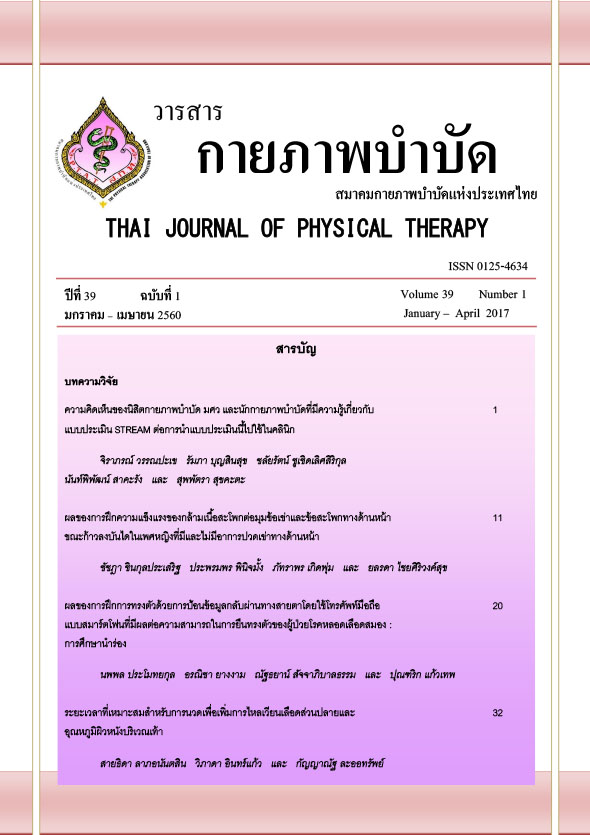ผลของการฝึกความแข็งแรงของกล้ามเนื้อสะโพกต่อมุมข้อเข่าและข้อสะโพกทางด้านหน้าขณะก้าวลงบันไดในเพศหญิงที่มีและไม่มีอาการปวดเข่าทางด้านหน้า
Main Article Content
บทคัดย่อ
Background: The weakness of hip abductor and external rotator muscles may result in altered hip and knee kinematics. Excessive hip adduction, hip internal rotation and knee valgus affect to increased patellofemoral joint stress and also contribute to patellofemoral pain syndrome. However, no study has investigated the effect of hip muscle strengthening program on hip and knee kinematics during step down in patellofemoral pain (PFP) persons.
Objectives: To investigate the effect of hip muscle strengthening program on hip adduction and knee valgus angles, and pain in females with and without PFP.
Methods: Fifteen females with PFP and fifteen females without PFP received hip strengthening program for 4 weeks. Hip muscle strength was measured by using hand-held dynamometer (HHD). Hip adduction and knee valgus angles during standing and step down were measured by using a video camera and Kinovea program version 0.8.15. Independent t-test was used to compare the hip and knee angles between PFP and control group.
Results: Both groups showed the significant increases in hip abductor and hip external rotator strength after performing hip strengthening program. PFP group exhibited significantly decreased knee valgus during step down task more than the control group (6.58, 0.47 degrees, p =.001). However, there was no significant differences in hip adduction during step down between PFP and control group (p=.138). Moreover, PFP group revealed significant improvement in the Kujala anterior knee pain scale (before 86.2, after 95.2, p < 0.001).
Conclusion: Hip strengthening program can increase hip muscle strength, decrease knee valgus and improve pain and function
Article Details
เอกสารอ้างอิง
2. Roush JR, Curtis Bay R. Prevalence of anterior knee pain in 18-35 year-old females. Int J Sports Phys Ther 2012; 7(4): 396-401.
3. Al-Hakim W, Jaiswal PK, Khan W, Johnstone D. The non-operative treatment of anterior knee pain. Open Orthop J 2012; 6: 320-6.
4. Bolgla LA, Malone TR, Umberger BR, Uhl TL. Comparison of hip and knee strength and neuromuscular activity in subjects with and without patellofemoral pain syndrome. Int J Sports Phys Ther 2011; 6(4): 285-96.
5. Carry PM, Kanai S, Miller NH, Polousky JD. Adolescent patellofemoral pain: a review of evidence for the role of lower extremity biomechanics and core instability. Orthopedics 2010; 33(7): 498-507.
6. Nakagawa TH, Muniz TB, Baldon Rde M, et al. The effect of additional strengthening of hip abductor and lateral rotator muscles in patellofemoral pain syndrome: a randomized controlled pilot study. Clin Rehabil 2008; 22(12): 1051-60.
7. Ireland ML, Willson JD, Ballantyne BT, Davis IM. Hip strength in females with and without patellofemoral pain. J Orthop Sports Phys Ther 2003; 33(11): 671-6.
8. Powers CM. The influence of abnormal hip mechanics on knee injury: a biomechanical perspective. J Orthop Sports Phys Ther 2010; 40(2): 42-51.
9. Robinson RL, Nee RJ. Analysis of hip strength in females seeking physical therapy treatment for unilateral patellofemoral pain syndrome. J Orthop Sports Phys Ther 2007; 37(5): 232-8.
10. Fukuda TY, Melo WP, Zaffalon BM, et al. Hip posterolateral musculature strengthening in sedentary women with patellofemoral pain syndrome: a randomized controlled clinical trial with 1-year follow-up. J Orthop Sports Phys Ther 2012; 42(10): 823-30.
11. Dolak KL, Silkman C, Medina McKeon J, et al. Hip strengthening prior to functional exercises reduces pain sooner than quadriceps strengthening in females with patellofemoral pain syndrome: a randomized clinical trial. J Orthop Sports Phys Ther 2011; 41(8): 560-70.
12. Songkroh P, Bunoam S, Wongthong J, Chaipinyo K. Reliability and relationship of the Thai version of Kujala anterior knee pain questionnaire and functional performance test. Special Project for Physical Therapy Program. Srinakharinwirot University, 2010.
13. Bazett-Jones DM, Cobb SC, Joshi MN, Cashin SE, Earl JE. Normalizing hip muscle strength: establishing body-size-independent measurements. Arch Phys Med Rehabil 2011; 92(1): 76-82.
14. Hollman JH, Ginos BE, Kozuchowski J, et al. Relationships between knee valgus, hip-muscle strength, and hip-muscle recruitment during a single-limb step-down. J Sport Rehabil 2009; 18(1): 104-17.
15. Distefano LJ, Blackburn JT, Marshall SW, Padua DA. Gluteal muscle activation during common therapeutic exercises. J Orthop Sports Phys Ther 2009; 39(7): 532-40.
16. Earl JE, Hoch AZ. A proximal strengthening program improves pain, function, and biomechanics in women with patellofemoral pain syndrome. Am J Sports Med 2011; 39(1): 154-63.
17. Khayambashi K, Mohammadkhani Z, Ghaznavi K, Lyle MA, Powers CM. The effects of isolated hip abductor and external rotator muscle strengthening on pain, health status, and hip strength in females with patellofemoral pain: a randomized controlled trial. J Orthop Sports Phys Ther 2012; 42(1): 22-9.


